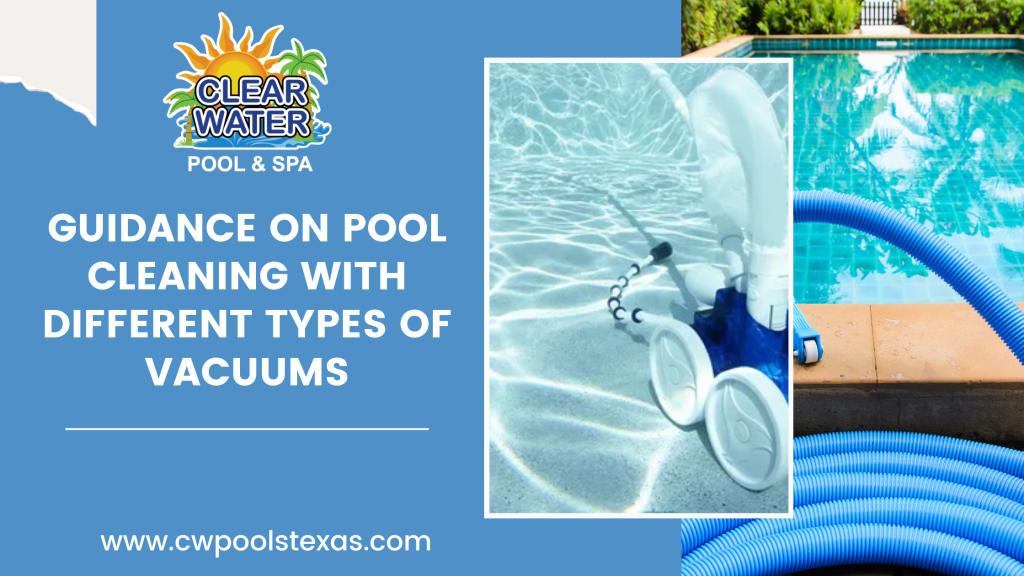Guidance on Pool Cleaning with Different Types of Vacuums
Explore effective pool cleaning methods using various types of pool vacuums. Learn how robotic, suction, and pressure pool vacuums can keep your pool sparkling clean.

A pool cleaner is like a special helper for your pool that works together with the equipment that cleans the water. It's there to catch the dirt and algae that might not get caught by the regular cleaning system. Some pools, like smaller ones above the ground, don't have their own cleaning machines, so the pool cleaner becomes the main way to keep the water clean.
If you are hiring a pool service in Corpus Christi to do the cleaning then it's great but if you are not then you will need some kind of DIY approach. That often means getting a pool vacuum cleaner or other tools.
But how do you pick the right pool cleaner for your pool? Keep reading to learn different choices, ranging from simple hand brushes to powerful automatic systems.
Types Of Pool Vacuums
Manual Cleaning with a Telescoping Pole
The traditional manual cleaning tools, such as brushes, skimmers, and scrubbers, attached to a telescoping pole, form the cornerstone of pool maintenance. These essential tools help you scrape the sides and bottom of your pool, effectively tackling those green and yellowish build-ups. While this method demands time and effort, it remains an economical and viable option.
Handheld Pool Vacuum Cleaners
Handheld pool vacuum cleaners are a practical solution for cleaning your pool, similar to how a standard vacuum cleaner works in your home. These devices require you to manually move them around the pool's surface for cleaning. They don't have complex mechanical parts, which makes them cost-effective and can improve your pool's filtration system.
However, it's essential to note that for larger pools, the cleaning process can be time-consuming, taking several hours to ensure a thorough clean.
Suction Pool Vacuum Cleaners
Suction pool vacuum cleaners, often referred to as suction-side cleaners, operate by utilizing the suction power from your pool's water intake. These swimming pool vacuums connect to your pool's pump, and they rely on the pump's suction force to collect debris from your pool. While they are generally effective at cleaning, they have a downside: they require your pool pump to be running while in use, which can lead to increased electricity consumption. Additionally, regular filter cleaning is necessary, especially if you have DE (diatomaceous earth) filters installed.
Robotic Pool Vacuum Cleaners
Among the most energy-efficient options, robotic pool vacuum cleaners operate independently of your pool's circulation system. Equipped with built-in filters and motors, they can tackle even the tiniest particles across various pool surfaces. Some models boast exciting features like remote controls and four-wheel drives for spot cleaning, making them a great fit for above-ground pools.
Pressure Pool Vacuum Cleaners
Pressure-side cleaners utilize the pump's power to navigate the pool's surfaces independently. While they lack the scrubbing action of contact-type cleaners, they excel at dealing with larger debris and soil. Equipped with filter bags, they don't stress the pool filter, and adding a booster pump can enhance their efficiency.
In-Floor Cleaning Systems
Designed for larger in-ground pools, in-floor cleaning systems integrate jets into the pool's bottom, producing a high-pressure swirl of water that pushes dirt and debris toward the main drains. This elaborate system, involving booster pumps and sophisticated water currents, offers a hands-free cleaning experience, making it ideal for meticulously planned in-ground pools.
How Often Should You Vacuum Your Pool?
High Usage or Debris-Prone Areas
If your pool experiences heavy usage which is often during special events, parties, or prolonged periods of consecutive swimming. More swimmers mean more dirt and debris carried into the pool. Or is located in an area with a lot of trees, plants, or other debris sources, you should consider vacuuming your pool about 1 to 2 times per week. This helps prevent debris buildup and maintains water clarity.
Moderate Usage and Normal Debris
For pools with moderate usage and a normal amount of debris, such as leaves and dirt, vacuuming every 1 to 2 weeks should suffice. This schedule helps keep the pool clean without excessive effort.
Low Usage and Minimal Debris
If your pool sees minimal use and is situated in an environment with very little debris, you can vacuum it every 2 to 4 weeks. This frequency maintains a clean pool while taking into account the lower level of contaminants.
Spot Vacuuming
Sometimes, unexpected debris finds its way into your pool after a storm or a windy day. Spot vacuuming comes to the rescue in these situations, addressing the immediate issue. A quick vacuum session will help you swiftly clear away any sudden influx of dirt and leaves, keeping your pool in top shape.
Seasonal Readiness
The changing seasons mark crucial moments for pool maintenance. When opening your pool for the season, a thorough vacuuming by pool services in Corpus Christi ensures a fresh start, free of winter debris. Similarly, as winter approaches and you prepare to close your pool, a final vacuuming session helps prevent excessive buildup, simplifying the opening process come summer.
Remember the key to keeping your pool clean is regular maintenance by vacuuming it and using proper pool chemicals from authorized sellers.
Ways To Vacuum Your Pool
Using the "Vacuum to Waste" Option for Effective Cleaning
When faced with substantial debris in your pool, employing the "vacuum to waste" option proves invaluable. By selecting this setting, you bypass the typical filter or cartridges and direct debris straight into the waste line. This is particularly useful when dealing with debris that could clog your filter, such as dirt, silt, and tiny particles that could accelerate filter wear and tear.
Different pool vacuum and filter systems may have distinct settings for waste vacuuming. Here's how to navigate them:
Multiport Valve Users
If you have a multiport valve, opt for the "waste" or "drain" setting. This directs the vacuumed debris straight to waste, preventing it from entering your filter.
Push-Pull Valve Users
The process depends on your filter type. DE (Diatomaceous Earth) filters and Sand filters are the most common types, each with their specific settings. If you're uncertain about your filter type or how to configure your vacuum for waste, consider seeking guidance from a certified pool technician.
Standard Vacuuming with Filter and Backwashing
For routine maintenance, standard vacuuming with a filtered setting is the go-to approach. This method ensures your pool remains consistently clean and well-maintained. As you vacuum, your filter captures various impurities, including dirt, debris, and algae spores. To prevent the accumulation of buildup, the next step is backwashing.
After the Vacuuming Session
- Shift the water flow to reverse and direct it towards the waste line.
- Allow the dirty water to flow out onto the ground or into a proper drain.
- Run the backwash until the expelled water runs clear, signifying the removal of trapped impurities.
This essential process applies to both self-cleaning pool vacuums and manual vacuuming methods. By adopting these practices, you ensure that your pool stays refreshingly clean, maintaining its inviting allure throughout the swimming season.
Leaf Trap Vacuuming
Some pool vacuum setups include a leaf trap, which is a canister that captures larger debris before it reaches the pool's filter. This prevents clogs and extends the life of your filter system.
Maximising Clarity with Pool Shocking
Before you shock your pool, make sure to vacuum it first. While shock treatments effectively handle various issues like algae, they might not clear out fine particles causing cloudiness. Vacuuming first eliminates larger debris, setting the stage for a successful shock treatment. This one-two punch ensures cleaner, clearer water, making your pool more inviting and enjoyable.
Duration For Vacuuming
The duration of running a pool vacuum varies based on the type of vacuum and the pool's size. Manual vacuuming takes about 1-2 hours for an average pool. Automatic cleaners, like suction-side or pressure-side, may need several hours. Robotic cleaners usually take 2-3 hours. Battery-powered vacuums are quick, around 30 minutes to 1 hour. Adjust based on debris and pool needs for a clean pool.
Remember as soon as your pool vacuum completes its cleaning cycle, it's best to remove it. Prolonged submersion can harm the vacuum's materials due to pool chemicals. Prompt removal ensures durability and prevents potential malfunctions, maintaining a safe and enjoyable swimming experience.
Call Pool Service In Corpus Christi For Effective Pool Maintenance
To maintain your pool effectively, consider using appropriate pool cleaners and vacuums, and stick to a consistent maintenance schedule. With the right tools and knowledge, your weekly pool cleaning tasks can become more efficient and enjoyable. Whether you choose a robotic pool vacuum, suction, or pressure cleaner, it's crucial to consider factors such as your pool's shape, size, and your budget.
If you require assistance with pool maintenance or need guidance on selecting the right products for pool cleaning, don't hesitate to reach out to professional pool service providers in Corpus Christi. They can offer expert advice and support to help you keep your pool in excellent condition.
About the Creator
John Harris
I'm John Harris, and I work as a manager at Clearwater Pool & Spa Co. in Corpus Christi, TX. We offer chemicals, vacuums, parts, above ground pools, and pool repair services.






Comments
There are no comments for this story
Be the first to respond and start the conversation.